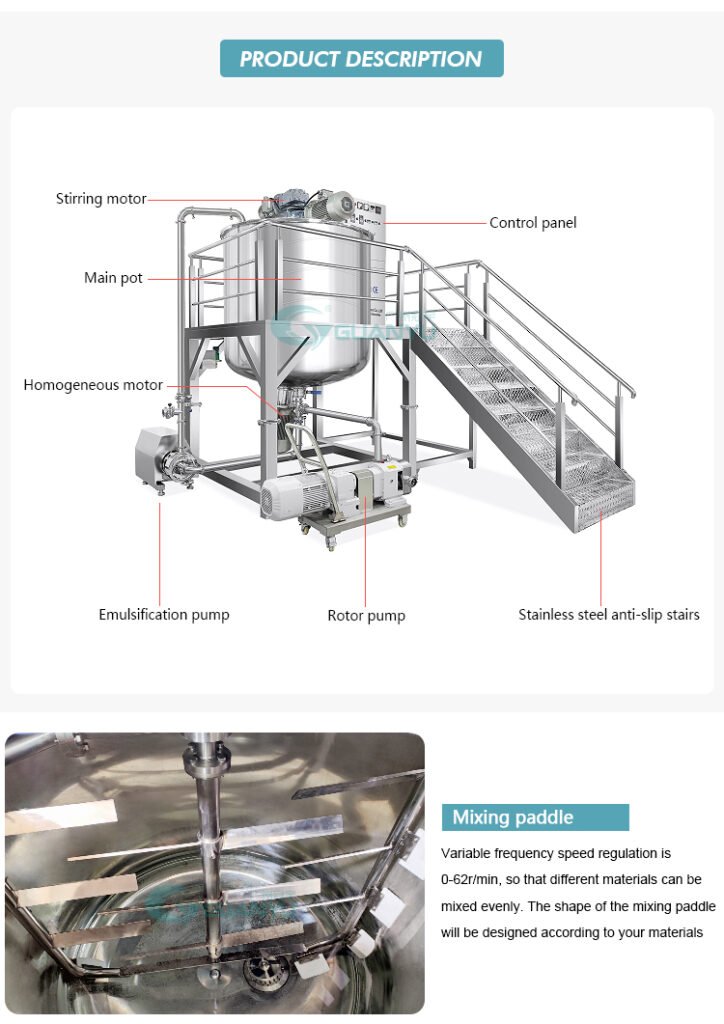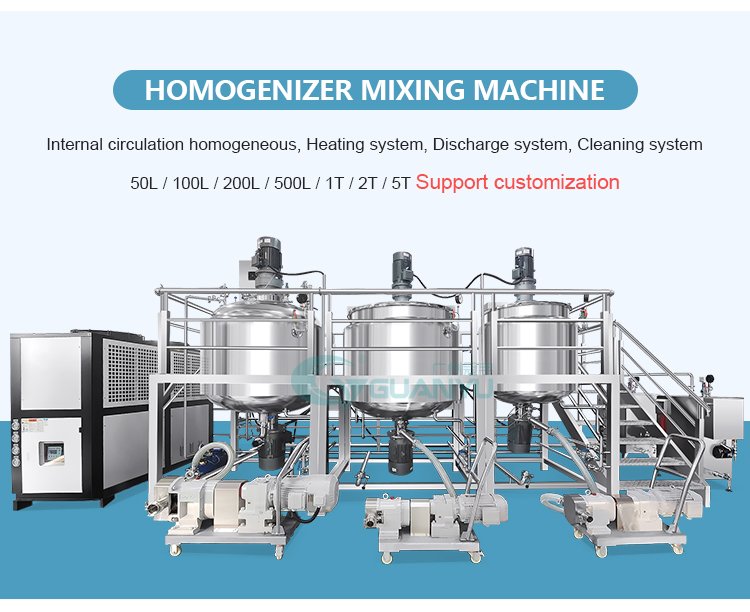أصبحت منعمات الأقمشة منتجًا منزليًا أساسيًا, تحويل الغسيل من عمل روتيني إلى تجربة أكثر متعة. لا تقوم هذه المنتجات بتنعيم الأقمشة فحسب، بل تقلل أيضًا من التشبث الساكن, جعل الكي أسهل, وإضفاء رائحة منعشة على الملابس. عملية إنتاج منعمات الأقمشة معقدة وتتطلب معدات دقيقة لضمان جودة المنتج النهائي واتساقه. أحد أهم قطع المعدات في هذه العملية هو وعاء الخلط. سوف تستكشف هذه المقالة عملية إنتاج منعمات الأقمشة, كيفية اختيار وعاء المزج المناسب, ومزايا وتطبيقات أوعية الخلط في تصنيع منتجات العناية المنزلية والشخصية.
مقدمة لإنتاج منعم الأقمشة
يتضمن إنتاج منعمات الأقمشة عدة مراحل, بدءًا من صياغة المواد الخام وحتى التغليف النهائي للمنتج. تشتمل المكونات الأساسية عادةً على المواد الخافضة للتوتر السطحي الكاتيونية, وهي المسؤولة عن تأثير التليين, بالإضافة إلى مكونات أخرى مثل العطور, الأصباغ, المواد الحافظة, والمكثفات.
الخطوات الرئيسية في إنتاج منعم الأقمشة
- صياغة وخلط: الخطوة الأولى هي صياغة مزيج المكونات. ويتم ذلك في وعاء الخلط حيث يتم قياس المواد الخام وإضافتها وفقًا لوصفة محددة.
- التدفئة والإثارة: للتأكد من خلط جميع المكونات جيدًا وإذابة أي مكونات صلبة, غالبًا ما يتم تسخين الخليط وتحريكه باستمرار. هذه الخطوة حاسمة لتحقيق خليط متجانس.
- التجانس: اعتمادا على الصيغة, قد يحتاج الخليط إلى التجانس لتحقيق مستحلب مستقر. هذه الخطوة مهمة بشكل خاص لضمان توزيع المكونات النشطة بالتساوي في جميع أنحاء المنتج.
- التبريد والتخفيف: بعد التجانس, يتم تبريد الخليط إلى درجة الحرارة المطلوبة وتخفيفه إلى التركيز النهائي. يمكن أن تتضمن هذه الخطوة أيضًا ضبط درجة الحموضة وإضافة أي مكونات حساسة للحرارة.
- الترشيح والتعبئة: يتم تصفية المنتج النهائي لإزالة أي شوائب أو جزيئات غير مذابة ومن ثم تعبئته في زجاجات أو حاويات أخرى.
اختيار وعاء المزج المناسب
وعاء الخلط, يُعرف أيضًا باسم خزان الخلط أو الخلاط, يلعب دورا محوريا في عملية الإنتاج. يعد اختيار وعاء الخلط المناسب أمرًا بالغ الأهمية لضمان كفاءة وجودة منعم الأقمشة.


العوامل التي يجب مراعاتها عند اختيار وعاء المزج
- سعة: يجب أن تتوافق سعة وعاء الخلط مع حجم الإنتاج. قد يتطلب الإنتاج على نطاق صغير أوعية سعة بضع مئات من اللترات, في حين أن العمليات واسعة النطاق قد تحتاج إلى سفن بسعة عدة آلاف من اللترات.
- بناء المواد: عادة ما تكون أوعية الخلط مصنوعة من الفولاذ المقاوم للصدأ بسبب مقاومتها للتآكل, متانة, وسهولة التنظيف. يعتبر الفولاذ المقاوم للصدأ ذا أهمية خاصة في الحفاظ على نقاء المنتج ومنع التلوث.
- قدرات التدفئة والتبريد: تتطلب بعض التركيبات تحكمًا دقيقًا في درجة الحرارة. يمكن للأوعية المجهزة بسترات أو ملفات تسخين أن تضمن وصول الخليط إلى درجة الحرارة اللازمة للمزج الأمثل. بصورة مماثلة, يمكن أن تساعد سترات التبريد في وصول الخليط بسرعة إلى درجة الحرارة المطلوبة بعد التسخين.
- آلية التحريض والخلط: يعد تصميم المحرض أمرًا بالغ الأهمية للخلط الفعال. تشمل الخيارات خلاطات المجداف, خلاطات توربينية, ومرساة المحرضين, كل منها مناسب لأنواع مختلفة من المنتجات. يجب أن توفر آلية الخلط قصًا كافيًا لمزج المكونات جيدًا دون التسبب في تهوية مفرطة.
- القدرة على الفراغ: تعتبر الأوعية ذات القدرات الفراغية مفيدة لإزالة الهواء ومنع الأكسدة أثناء عملية الخلط. وهذا مهم بشكل خاص للمنتجات الحساسة للهواء أو التي تتطلب نعومة, اتساق خالي من الهواء.
- التعقيم والتنظيف: يجب أن يكون الوعاء سهل التنظيف والتعقيم لمنع التلوث بين الدفعات. ميزات مثل CIP (نظيفة في مكانها) يمكن للأنظمة أتمتة وتبسيط عملية التنظيف.

مزايا استخدام أوعية المزج
توفر أوعية الخلط العديد من المزايا في إنتاج منعمات الأقمشة ومنتجات العناية الشخصية الأخرى.
خلط متجانس
تم تصميم أوعية الخلط لتوفير خلط شامل ومتسق للمكونات, ضمان منتج متجانس. يعد هذا التوحيد أمرًا بالغ الأهمية لأداء منعم الأقمشة, حيث أن أي توزيع غير متساوٍ للمكونات النشطة يمكن أن يؤدي إلى نتائج غير متناسقة.
كفاءة التدفئة والتبريد
تسمح أنظمة التدفئة والتبريد المدمجة في أوعية الخلط بالتحكم الدقيق في درجة الحرارة. هذه القدرة ضرورية للذوبان في بعض المكونات واستقرار المنتج النهائي. يمكن أن تؤدي الإدارة الفعالة لدرجة الحرارة أيضًا إلى تقليل وقت الإنتاج واستهلاك الطاقة.
معالجة الفراغ
يوفر خيار استخدام المعالجة الفراغية في أوعية الخلط العديد من الفوائد. فهو يساعد على إزالة الهواء المحبوس, تقليل مخاطر الأكسدة وتحسين العمر الافتراضي للمنتج. تساعد معالجة الفراغ أيضًا في تحقيق السلاسة, اتساق خالي من الكتل, وهو أمر مهم للصفات الجمالية والوظيفية لمنعم الأقمشة.
قابلية التوسع
تأتي أوعية الخلط بأحجام مختلفة, مما يجعل من السهل زيادة الإنتاج مع زيادة الطلب. تعد قابلية التوسع هذه مفيدة للشركات المصنعة التي تتطلع إلى توسيع عملياتها دون إجراء تغييرات كبيرة على البنية التحتية للإنتاج الخاصة بها.
الأتمتة والتحكم
غالبًا ما تكون أوعية الخلط الحديثة مجهزة بأنظمة تحكم متقدمة تسمح بالمراقبة الدقيقة وتعديل المعلمات المختلفة مثل درجة الحرارة, سرعة الخلط, ومستوى الفراغ. تعمل الأتمتة على تحسين اتساق العملية, يقلل من احتمالية الخطأ البشري, ويعزز كفاءة الإنتاج الشاملة.
تطبيقات أوعية المزج في تصنيع منتجات العناية المنزلية والشخصية
لا تقتصر أوعية الخلط على إنتاج منعمات الأقمشة. يتم استخدامها على نطاق واسع في تصنيع العديد من منتجات العناية المنزلية والشخصية نظرًا لتعدد استخداماتها وفعاليتها.
المنظفات والمنظفات
بالإضافة إلى منعمات الأقمشة, تعتبر أوعية الخلط جزءًا لا يتجزأ من إنتاج المنظفات السائلة والمنظفات المنزلية. تتطلب هذه المنتجات خلطًا شاملاً للمواد الخافضة للتوتر السطحي, المذيبات, وغيرها من الإضافات لتحقيق أداء التنظيف والاستقرار المطلوب.
مستحضرات التجميل ومستلزمات النظافة
تعتمد صناعة مستحضرات التجميل بشكل كبير على أوعية الخلط لإنتاج الكريمات, المستحضرات, شامبو, ومكيفات. غالبًا ما تشتمل هذه المنتجات على تركيبات معقدة تتطلب خلطًا دقيقًا والتحكم في درجة الحرارة لضمان استقرار وفعالية المكونات النشطة.
الأدوية
في صناعة الأدوية, تُستخدم أوعية الخلط لخلط المكونات المختلفة لإنتاج الأدوية السائلة, شراب, والعلاجات الموضعية. تعد القدرة على الحفاظ على معايير النظافة الصارمة ومنع التلوث ذات أهمية خاصة في هذا المجال.
الأطعمة والمشروبات
تُستخدم أوعية الخلط أيضًا في صناعة الأغذية والمشروبات لخلط المكونات في إنتاج الصلصات, الضمادات, والمشروبات. إن تعدد استخدامات هذه السفن وكفاءتها يجعلها مناسبة لمجموعة واسعة من التطبيقات.

خاتمة
يعتبر وعاء الخلط مكونًا لا غنى عنه في عملية إنتاج منعمات الأقمشة ومجموعة متنوعة من منتجات العناية المنزلية والشخصية الأخرى. دورها في ضمان الخلط المتجانس للمكونات, التحكم الفعال في درجة الحرارة, والقدرة على العمل في ظل ظروف الفراغ تجعلها أحد الأصول المهمة في التصنيع الحديث. من خلال اختيار وعاء الخلط المناسب بعناية بناءً على السعة, بناء المواد, قدرات التدفئة والتبريد, آلية التحريض, وظيفة الفراغ, وقابلية التنظيف, يمكن للمصنعين تعزيز كفاءة الإنتاج وجودة المنتج بشكل كبير.
ختاماً, إن دمج أوعية الخلط المتقدمة في عملية الإنتاج لا يؤدي إلى تحسين سير عمل التصنيع فحسب، بل يضمن أيضًا أن المنتج النهائي يلبي أعلى معايير الجودة والأداء. مع استمرار نمو الطلب على منتجات العناية المنزلية والشخصية عالية الجودة, ستظل أهمية أوعية الخلط الموثوقة والفعالة ذات أهمية قصوى في الصناعة.